Notes: The terminus at Polton opened on 15 April 1867. It had a single platform on the down side of the line with a run-round loop. The original station building was very small, but the station was substantially rebuilt around the turn of the twentieth century with a new building and additional sidings.
The station building was rectangular in shape, stone-built with a pitched slate roof and a wide canopy along its full length, reaching to the edge of the platform. The booking office was at the south end of the building with a general waiting room, ladies’ waiting room and a gents’ toilet at the north end of the building. When the station was rebuilt a single-storey brick-built stationmaster’s house was provided on Polton Bank to the south of the goods yard.
| The station had a moderate sized goods yard with a four-ton crane and three sidings opposite the platform. One of the sidings was used to stable the branch locomotive when necessary as there was never an engine shed. Access to the yard was controlled from a tall signal box adjacent to Polton Cottages to the north of the station. There was also a private siding to |
 |
Springfield paper mill which ran to the west of the station building and across Polton Road to the large mill complex on the far side of the road. A second private siding involved a reversal in the goods yard running parallel with the line to Polton Mill, which was north of the station on the up side. A third paper mill was rail-connected: this was Kevock Mill, on the up side of the line by the second crossing over the North Esk between Polton and Lasswade.
After closing to passengers in 1951 the station remained open for goods traffic, finally closing from 18 May 1964.
One of the main reasons for building the Polton branch was to serve the paper mills along the North Esk valley. Kevock Mill is believed to have been started around 1850 by Archibald Somerville, and its closure date is not known. Polton Mill was established in 1750 as the Polton Paper Mill Company and expanded by Edinburgh bankers Arbuthnot and Guthrie and Forbes Hunter & Co. Bankrupt in 1772, the mill was closed and sold to William Simpson of Polton. By the early 1790s Simpson was responsible for a number of papermaking innovations including the first use of chlorine bleach in Scotland ‘in bleaching or whitening his paper stuff’. The mill closed shortly after the Second World War. Springfield is believed to have been originally established in 1717 but had several periods of closure in its early years. It was substantially expanded in the twentieth century with an extended network of sidings, finally closing in 1968.
BRIEF HISORY OF THE ESK VALLEY RAILWAY (More detailed history being prepared)
Lying on the banks of the North Esk River in Midlothian, the small village of Polton is situated in a deep gorge a mile south-east of Loanhead and a mile south-west of Bonnyrigg. During the 19th and 20th centuries Polton was associated with two large paper mills (Springfield Mill opened in 1742 and Polton Mill in 1850) and Mavisbank House lies nearby; it was once one of Scotland's finest buildings. It was designed by William Adam for Sir John Clerk as a summer residence and at a convenient travelling distance from Edinburgh while he was working there. From the late 19th century until 1951 it was used as a hospital for the mentally ill, but later, back in private ownership, it was gutted by fire in 1973 and is now a ruin. Author and poet Thomas De Quincey died at a cottage in the village in 1859.
The Peebles Railway opened on 1 February 1864, and it quickly became profitable, prompting a number of local schemes in and around the North Esk valley over the next two decades.
One of first was the Esk Valley Railway whose promoters wanted to build a short branch from the Peebles Railway to serve the paper mills along the North Esk Valley
 |
Discussions with the NBR started in January 1863. The EVR’s proposed route involved using Peebles Railway land and building a separate track parallel with the Peebles Railway for just over half a mile from the junction with the Edinburgh & Hawick line at Hardengreen. After diverging from the PR the line would continue eastwards through the northern part of |
Bonnyrigg to a terminus at Polton: a total length of just over two miles.
The EVR was strongly supported by the NBR who planned to lease and operate the line once it opened. There was, however, opposition to the scheme from the Caledonian Railway who had their own plans for new lines to the south of Edinburgh
The local company won through, obtaining its Act on 21 July 1863. Construction started on 5 September 1864, and arrangements for working the line were agreed with the NBR on 28 September. Initial progress was slow due to engineering difficulties and further ongoing opposition from the Caledonian Railway.
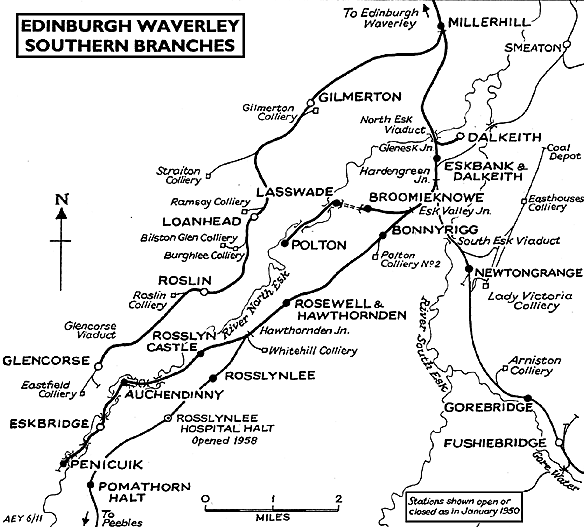 |
Although the single-track branch was only just over two miles in length it was heavily engineered for much of its route through the narrow North Esk valley. Major structures included the 430 yd Broomieknowe tunnel just east of Lasswade station and, beyond the station, a high six-arch stone curved viaduct taking the line obliquely across the North Esk valley. After this the line dropped sharply down the hillside before crossing back over the river by a much lower two-span girder bridge to reach the cramped terminus at Polton after a further half mile. Although only a mile from the town of Loanhead, Polton was hidden deep in the valley and could be reached only by steep and narrow minor roads.
The North British Railway (Lasswade and Branches) Act 1865 gave the NBR powers to construct a line from the unfinished EVR at Lasswade swinging north and west of Loanhead to Penicuik. This line was also planned to join the Edinburgh & Glasgow Railway to give access to the west. The powers were never taken up, although a branch to Penicuik from the Peebles |
 |
Railway did eventually open in 1872.
The Esk Valley Railway finally opened on 16 April 1867 with one intermediate station at Bonnyrigg. As both the EVR and the PR had their own tracks between the north-facing Esk Valley Junction and Harden Green Junction the two companies came to an agreement to share the two lines operating both as a section of double-track line.
.gif) |
There were issues over station names. Before the branch opened, the NBR wanted to call the first station Bonnyrigg as it was closer to the town centre than Bonnyrigg station on the Peebles Railway. The PR were reluctant to change the name of their station despite protests from the NBR, claiming that a name change would confuse passengers. The PR were eventually persuaded to reconsider, and the PR station became Bonnyrigg Road in December 1866. As predicted by the PR passengers were confused, and the EVR station was renamed Broomieknowe on 1 August 1868. After pressure from the NBR a second intermediate station was opened at Lasswade just under half-a-mile west of Broomieknowe on 12 October 1868. After operating the line from the start the North British absorbed the Esk Valley Railway on 13 July 1871.
 |
In 1887 there were six daily trains in each direction between Edinburgh Waverley and Polton. There was, however, no early morning train: the first departure from Edinburgh was at 9.25am with a journey time between Eskbank and Polton of 12 minutes. There was no Sunday service. By 1922 there was one additional service leaving Edinburgh at 7.00am |
By 1950 there were still six trains in each direction, but by this time they carried very few passengers, and the line closed to passengers on 10 September 1951. It remained open for goods traffic until 18 May 1964 following the run down of the mills. Springfield Mill finally closed in the late 1960s.
The course of the Esk Valley Railway is traceable for much of its length although no part of it has been designated as a public footpath. The tunnel at Lasswade has been bricked up (with a locked door) at both ends although both portals are fairly easily accessible. Lasswade Viaduct is Grade B listed and is not accessible.
Ticket from Michael Stewart, route map drawn by Alan Young.
Sources:
To see other stations on the Esk Valley Railway click on the station name:
Broomieknowe & Lasswade |

old3.jpg)

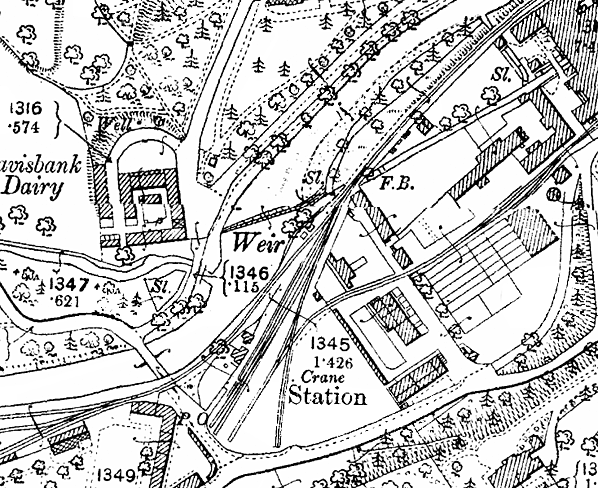
 1907 1:2,500 OS map. Polton station has been substantially rebuilt.
1907 1:2,500 OS map. Polton station has been substantially rebuilt.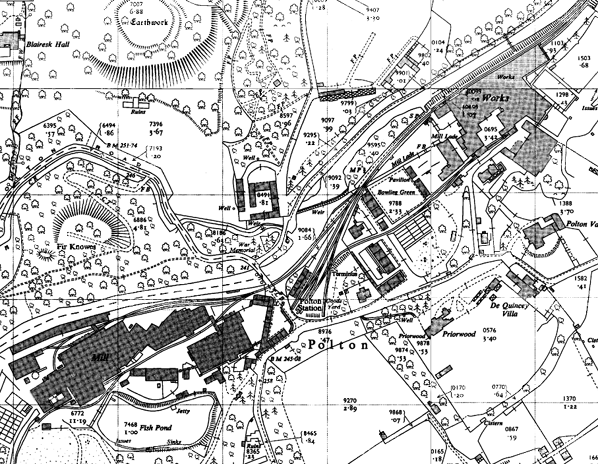 1958 1:2,500 OS map showing sidings serving Springfield Mill (left) and Polton Mill (right).
1958 1:2,500 OS map showing sidings serving Springfield Mill (left) and Polton Mill (right).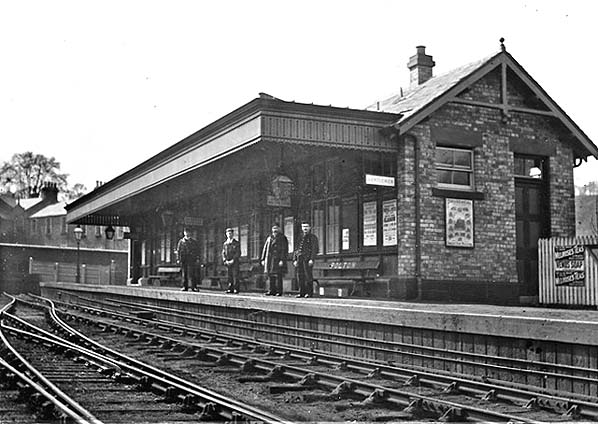 Pre-grouping view of Polton station.
Pre-grouping view of Polton station.old1.jpg) An Edinburgh Waverley train at Polton station in May 1949. 67492 was built in April 1916 to a Reid design for the NBR and classed L. It was absorbed into the LNER, renumbered 9448 and classed as C16. Renumbered again by the LNER to 7492 and by BR to 67492, this 4-4-2 Atlantic tank was withdrawn on 31.3.1960 from St Margarets and cut up at Cowlairs works in April that
An Edinburgh Waverley train at Polton station in May 1949. 67492 was built in April 1916 to a Reid design for the NBR and classed L. It was absorbed into the LNER, renumbered 9448 and classed as C16. Renumbered again by the LNER to 7492 and by BR to 67492, this 4-4-2 Atlantic tank was withdrawn on 31.3.1960 from St Margarets and cut up at Cowlairs works in April thatold5.jpg)
old6.jpg)
old7.jpg)
old10.jpg)
old4.jpg)
1.jpg)
3.jpg)

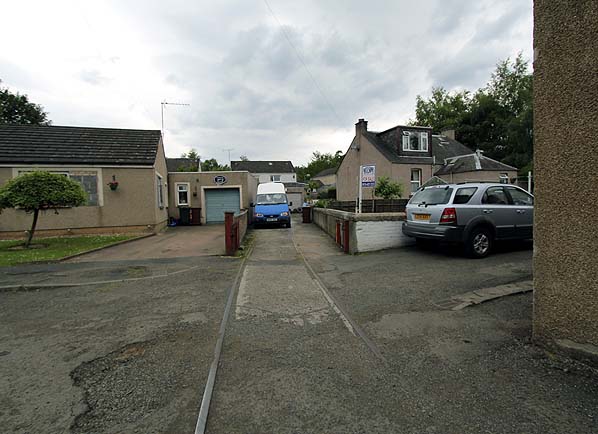




.gif)

old_thumb8.jpg)
old_thumb9.jpg)
old_thumb2.jpg)
thumb2.jpg)



mill_thumb.jpg)
 Home Page
Home Page